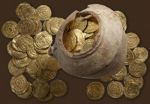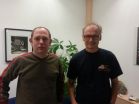'Basarab' surname may not indicate direct relation to Vlad the Impaler
Genographic project study gives insight into Romanian royal dynasty
2012-07-26
(Press-News.org) WASHINGTON—A study by the Genographic Project has shown that not all individuals carrying the Romanian "Basarab" surname, the first dynasty of Wallachian kings that included the real-life Dracula, can be direct biological descendants of the Basarab dynasty.
The Basarab dynasty ruled Wallachia, the historical and geographical southern region of present-day Romania, for almost three centuries (1330-1601) and had among its members Vlad III the Impaler, commonly known as Dracula. The ethnic origin of the Basarab family has long been a dispute among historians, with both an Indo-European/Romanian and an Asian Cuman/Turkic origin being suggested. Published today in the journal PLOS ONE, the research was led by Genographic Project Principal Investigator David Comas of the Genographic Project's Western/Central Europe regional center.
The study analyzed the Y-chromosome diversity of 29 Romanian individuals carrying the Basarab surname and compared it with the diversity found in about 150 Romanians from different regions of the country and some 330 individuals from surrounding populations of Ukraine, Hungary and Bulgaria. Different Y-chromosome lineages were found among the individuals that currently carry the name Basarab, which indicates that not all of them could be direct descendants of the Basarab dynasty. Extra-pair paternity could explain the existence of different male lineages, but the high genetic diversity found in the Basarab individuals indicates that Basarab is most likely a polyphyletic name, with multiple unrelated male founders.
"Patrilineal surnames are common in most European countries and are useful markers for male ancestry to answer questions related to the history and structure of human populations. The study of the Y chromosome in males with the Basarab surname is the first genetic analysis on the surname of a royal dynasty," said Comas.
All Y-chromosome lineages identified in modern-day Romanians bearing the Basarab name have typical Eastern-European haplotypes that were earlier found in both Romanians and Cumans, a population of Asian origin, rather than carrying eastern Asian haplogroups more specific for Cumans. "The present study shows that genetic haplogroup composition of the Basarab is very similar to that of the general Romanian population, and none of the haplogroups they carry is of Central or East Asia. However, these results cannot definitively distinguish between a Cuman or a Romanian origin for the Basarab dynasty, and only genetic analysis of ancient DNA from the actual remains of the Wallachian kings will be able to give a definitive answer," said Genographic Romanian collaborator Mihai Netea.
One certain conclusion, however, based on the relative heterogeneity of Y-chromosome lineages in modern Basarab from Romania, is that the Basarab dynasty was successful in spreading its name beyond the spread of their genes.
Genographic Project Director and National Geographic Explorer-in-Residence Dr. Spencer Wells noted that while the current study failed to find a recent common origin for all of the Basarab men, "There were telltale signs of related lineages among some of the men that suggested a close relationship that probably predated the establishment of the Basarab dynasty. It would certainly be interesting to extend the study of present-day populations to known Basarab remains to see if they belong to these lineages. Although we didn't identify Vlad the Impaler's Y-chromosome signature in this study, it might still be lurking in the dataset, waiting to be teased out with additional analyses."
###
For more information on the study, visit http://dx.plos.org/10.1371/journal.pone.0041803.
Background: The Genographic Project seeks to chart new knowledge about the migratory history of the human species and answer age-old questions surrounding the genetic diversity of humanity. The project is a nonprofit, multi-year, global research partnership of National Geographic and IBM with field support by the Waitt Family Foundation. At the core of the project is a global consortium of 11 regional scientific teams following an ethical and scientific framework and responsible for sample collection and analysis in their respective regions. Members of the public can participate in the Genographic Project by purchasing a public participation kit from the Genographic website (www.genographic.com), where they can also choose to donate their genetic results to the expanding database. Sales of the kits help fund research and support a Legacy Fund for indigenous and traditional peoples' community-led language revitalization and cultural projects.
ELSE PRESS RELEASES FROM THIS DATE:
2012-07-26
New Rochelle, NY, July 26, 2012— Administering high-doses of interleukin-2 (IL-2) has been the preferred treatment for patients with stage IV metastatic melanoma. An article published in the current issue of Cancer Biotherapy and Radiopharmaceuticals, a peer-reviewed journal from Mary Ann Liebert, Inc. (http://www.liebertpub.com), explores whether or not this regimen is still the most effective. The article is available free online at the Cancer Biotherapy and Radiopharmaceuticals website (http://www.liebertpub.com/cbr).
In the article "Should High-Dose Interleukin-2 ...
2012-07-26
We all know that, for the most part, it's wrong to kill other people, it's inappropriate to wear jeans to bed, and we shouldn't ignore people when they are talking to us. We know these things because we're bonded to others through social norms – we tend to do things the same way people around us do them and, most importantly, the way in which they expect us to do them.
Social norms act as the glue that helps to govern social institutions and hold humans societies together, but how do we acquire these norms in the first place?
In a new article published in the August ...
2012-07-26
Predictors of disease severity in human papillomavirus-derived head and neck cancer, tobacco use, and the dramatic benefits of robotic surgery in people with head and neck cancer are among landmark research presented by Mount Sinai School of Medicine at the Eighth International Conference on Head and Neck Cancer. The meeting took place from July 21-25, 2012 in Toronto.
Highlights of Mount Sinai research at the American Head and Neck Society conference:
Transoral Robotic Surgery Shows Significant Promise in Hard-to-Treat Smokers with Head and Neck Cancer
In a retrospective ...
2012-07-26
A team of researchers from Tel Aviv University has uncovered a hoard of real-life buried treasure at the Crusader castle of Arsur (also known as Apollonia), a stronghold located between the ancient ports of Jaffa and Caesarea, in use from 1241 to its destruction in 1265. The hoard, comprised of 108 gold coins, mostly dinars dated to the Fatimid Period (ca. 900 to 1100 AD), was discovered in a pot by a university student. The coins bear the names of sultans and blessings, and usually include a date and a mint name that indicates where a coin was struck.
This fascinating ...
2012-07-26
RICHMOND, Va. (July 26, 2012) – Patients suffering from the chronic lung condition COPD, which is the third-leading cause of death and disability in the United States, may benefit greatly from a three-times-a-week dose of an antibiotic, according to a study by Virginia Commonwealth University physicians published in today's issue of the New England Journal of Medicine.
Approximately 24 million Americans suffer from COPD, or chronic obstructive pulmonary disease, which creates recurrent, acute episodes of severe shortness of breath, cough and sputum production. Every ...
2012-07-26
URBANA – A lot of time, effort, and money are spent by agencies, municipalities, and other non-governmental organizations to inform and educate the public about environmental concerns. Could these groups collaborate to inform the public about an environmental concern even though their beliefs may be very different? Two studies suggest that they can and should.
University of Illinois professional geographer Bethany Cutts tracked messages to the public about water quality and usage from a variety of sources in Phoenix, Arizona. She found that considerable overlap in the ...
2012-07-26
University Park, Pa. -- Text messaging may offer tweens a quick way to send notes to friends and family, but it could lead to declining language and grammar skills, according to researchers.
Tweens who frequently use language adaptations -- techspeak -- when they text performed poorly on a grammar test, said Drew Cingel, a former undergraduate student in communications, Penn State, and currently a doctoral candidate in media, technology and society, Northwestern University.
When tweens write in techspeak, they often use shortcuts, such as homophones, omissions of non-essential ...
2012-07-26
A new versatile measurement system devised by researchers at the National Institute of Standards and Technology (NIST) accurately and quickly measures the electric power output of solar energy devices, capabilities useful to researchers and manufacturers working to develop and make next-generation solar energy cells.
Innovative devices that convert sunlight to electric power more efficiently and cost effectively than the current generation of solar cell technology are the objects of a global pursuit—means to reducing fossil-fuel consumption and to securing pole position ...
2012-07-26
This press release is available in German.
Excitation of neurons depends on the selected influx of certain ions, namely sodium, calcium and potassium through specific channels. Obviously, these channels were crucial for the evolution of nervous systems in animals. How such channels could have evolved their selectivity has been a puzzle until now. Yehu Moran and Ulrich Technau from the University of Vienna together with Scientists from Tel Aviv University and the Woods Hole Oceanographic Institution (USA) have now revealed that voltage-gated sodium channels, which ...
2012-07-26
Boston, MA – Men diagnosed with prostate cancer are less likely to die from the disease than from largely preventable conditions such as heart disease, according to a new study from Harvard School of Public Health (HSPH). It is the largest study to date that looks at causes of death among men with prostate cancer, and suggests that encouraging healthy lifestyle changes should play an important role in prostate cancer management.
"Our results are relevant for several million men living with prostate cancer in the United States," said first author Mara Epstein, a postdoctoral ...
LAST 30 PRESS RELEASES:
[Press-News.org] 'Basarab' surname may not indicate direct relation to Vlad the Impaler
Genographic project study gives insight into Romanian royal dynasty



